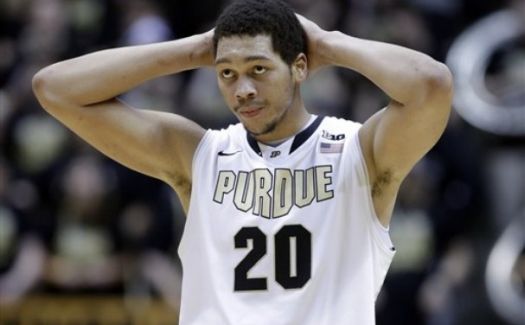Big Ten M5: 02.25.14 Edition
Posted by Alex Moscoso on February 25th, 2014- Last week, I stated Terran Pettaway was probably not going to win Big Ten POTY because he plays for a team unlikely to make the NCAA Tournament and his efficiency numbers were considerably lower than other contenders like Nik Stauskas. Well that might be changing as Nebraska keeps winning and Pettaway keeps dropping 20+ points, like he has in his last three games. He’s impressed so much that BTN.com’s Player of the Year Tracker now has him ranked as the front-runner for the award. Pettaway will need to keep up the strong performances, since the award is mostly given to a player from a top-tier team. While Nebraska has been as impressive as any team in the last few weeks, they are at best a bubble team. So Pettaway will really need to separate himself if he is to make his case against other players.
- It seems like we may never see a fully healthy Michigan State. Tom Izzo stated on Monday he would continue to play Keith Appling throughout the regular season. Appling is recovering from a wrist injury and did not play particularly inspiring basketball at Michigan on Sunday — finishing with only six points and two assists in twenty-five minutes. The Spartans have been trading wins and losses for almost four weeks now and Izzo needs all the men who are able to play out on the court to challenge for top seeding in the NCAA Tournament. For Izzo’s sake, Appling will need to either mend while playing or learn to live with the pain in order to get to this team’s goal of a Final Four appearance.
- It’s always tough to see players go down with season-ending injuries, but it’s even tougher when it happens to a senior. This is exactly what happened to Purdue’s Sterling Carter when he tore his ACL in Sunday’s game at Nebraska. Carter transferred from Seattle University to finish his career playing in the bright lights of the Big Ten. And while his season was cut short, Carter did get to finish his career, and play over twenty games, at a level he was not recruited at coming out of high school. There have been debates about whether the graduate transfer rule is beneficial or harmful to the game on the whole. But one of the positives are players like Carter who get the experience of playing big time basketball after proving himself in the low major levels –even if it is short lived.
- After a dominating performance on Saturday, Nik Stauskas may be back to his dominating ways. That’s good news for Michigan, but bad news for the rest of the league. He put on a show against Michigan State, scoring 25 points, 21 of which came in the second half. If Stauskas has indeed awoken from his February slump, he may run away with both the Big Ten regular season championship and the Big Ten POTY. That’s an amazing jump in performance from last season when he was thought of simply as a shooter. In the beginning of the season, most pundits though it impossible that any Wolverine could replace Trey Burke. And while Stauskas can’t run a team like Burke, he has a chance to give Michigan a consecutive Final Four appearance and Big Ten POTY.
- If you wanted to tweet at your favorite Iowa player this week, well, you can forget it now. Fran McCaffery has instructed his players to shut down their twitter accounts for the remainder of the season after Zach McCabe reacted to some negative comments made to him on the social media platform. Coaches are free to manage their team as they see fit and if McCaffery believes shutting down Twitter will help his team’s performance, more power to him. But perhaps it’s not by coincidence that shutting down Twitter (or removing names on the back of jerseys, etc.) always occurs after a tough loss. No coach seems to ban Twitter after a win. This appears like a reactionary maneuver from a coach trying to find any edge he can as the season comes to a close.













































